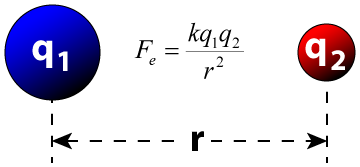Coulomb's Law is a fundamental principle in electrostatics, a branch of physics that deals with the study of electric charges and their interactions. It describes the force of attraction or repulsion between two charged objects due to their electric charges. The law is named after Charles-Augustin de Coulomb, a French physicist who formulated it in the 18th century.
Statement of Coulomb's Law
Coulomb's Law states that the force (F) between two point charges is directly proportional to the product of their magnitudes (q₁ and q₂) and inversely proportional to the square of the distance (r) separating them. Mathematically, it is expressed as: F = k |q₁ q₂| / r²

Where:
- F is the magnitude of the electrostatic force between the charges q₁ and q₂.
- k is the electrostatic constant, also known as Coulomb's constant, and it represents the proportionality factor in the law. Its value depends on the choice of units and the medium in which the charges exist.
- |q₁| and |q₂| are the magnitudes of the point charges.
- r is the distance between the centers of the two charges.
Direction of the Force
Coulomb's Law also provides information about the direction of the electrostatic force. The force is attractive if the charges are of opposite sign (one is positive, and the other is negative), and it is repulsive if the charges have the same sign (both positive or both negative).
- If q₁ and q₂ are both positive, the force is repulsive, pushing the charges apart.
- If q₁ and q₂ are both negative, the force is repulsive, again pushing the charges apart.
- If q₁ is positive and q₂ is negative, the force is attractive, pulling the charges toward each other.
Magnitude of the Force
The magnitude of the electrostatic force F can be calculated using Coulomb's Law, provided you have the values of the charges and the distance between them. It is important to note that the force is always positive, as it represents the magnitude of the force, regardless of whether the force is attractive or repulsive.
Units of Charge
In the International System of Units (SI), the unit of charge is the coulomb (C). One coulomb is defined as the charge that, when placed one meter apart from an identical charge, produces an electrostatic force of 9 × 10^9 newtons.
Applications of Coulomb's Law
Coulomb's Law, which describes the electrostatic interaction between charged particles, has numerous practical applications across various fields of science and technology. Here are some detailed applications of Coulomb's Law:
Electrostatic Force in Chemistry and Biology
Chemical Bonding
Coulomb's Law helps explain the formation of chemical bonds in molecules. In ionic bonding, for example, positively charged ions (cations) and negatively charged ions (anions) are attracted to each other due to electrostatic forces.
Protein Folding
The interactions between charged amino acid residues in proteins are governed by Coulomb's Law. These interactions play a crucial role in determining the three-dimensional structure and stability of proteins.
Electric Fields and Capacitors
Capacitors: Coulomb's Law is used to calculate the electrostatic force between the plates of a capacitor. This principle is fundamental in designing electrical energy storage devices used in electronics and power systems.
Electrostatic Precipitators
Air Pollution Control: Electrostatic precipitators use the principles of Coulomb's Law to remove particulate matter from industrial exhaust gases. Charged particles are attracted to collector plates, effectively reducing air pollution.
Particle Accelerators
Particle Physics: In high-energy particle accelerators like the Large Hadron Collider (LHC), Coulomb's Law is crucial for understanding and controlling the trajectories of charged particles, such as electrons and protons, as they are accelerated to high velocities.
Electrostatic Printing and Photocopying
Printers and Photocopiers: Electrostatic principles, including Coulomb's Law, are applied in electrophotography (commonly known as photocopying or laser printing). A charged drum attracts toner particles to create images on paper.
Ionization and Mass Spectrometry
Mass Spectrometry: Mass spectrometers utilize Coulomb's Law to accelerate ions and analyze their mass-to-charge ratios. The electrostatic forces guide ions through the instrument and help separate them based on their mass and charge.
Electrostatic Motors and Actuators
Electromechanical Devices: Electrostatic forces, including Coulomb's Law, are utilized in various microelectromechanical systems (MEMS) and nanoelectromechanical systems (NEMS) for actuation and sensing purposes. These devices are used in sensors, switches, and microactuators.
Semiconductor Devices
Transistors and Integrated Circuits: In semiconductor devices like MOSFETs (Metal-Oxide-Semiconductor Field-Effect Transistors), the control of electric charge, and thus the application of Coulomb's Law, is central to their operation, enabling electronic amplification and switching.
Charged Particle Traps
Ion Traps: In ion trap mass spectrometers and quantum computing systems, charged particle traps use electric fields based on Coulomb's Law to confine and manipulate ions and quantum bits (qubits).
Plasma Physics
Nuclear Fusion: Coulomb's Law plays a role in plasma physics, particularly in the study of nuclear fusion reactions in devices like tokamaks. Controlling and understanding the behavior of charged particles in plasma is essential for achieving controlled fusion.
Space Exploration
Spacecraft Propulsion: Coulomb's Law is relevant in the field of electric propulsion for spacecraft, where charged ions are accelerated to generate thrust. This technology is used for deep-space missions.
Astrophysics
Stellar and Galactic Dynamics: Coulomb's Law is applied in astrophysics to understand the gravitational and electrostatic interactions between charged particles in space, such as ions in plasmas within stars and galaxies.
Coulomb's Law, with its ability to describe and predict the behavior of electric charges, is a foundational concept in modern physics and engineering. Its applications range from understanding the structure of matter at the atomic and molecular level to designing advanced technology and solving complex problems in various scientific disciplines.
